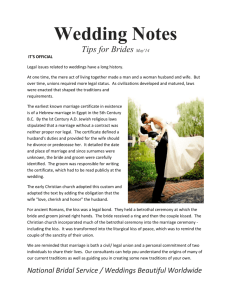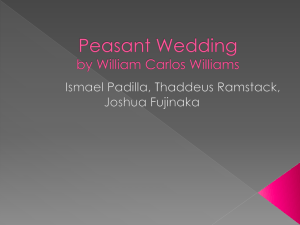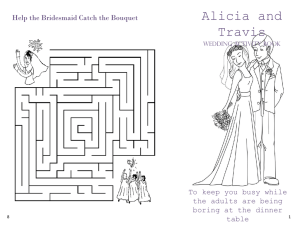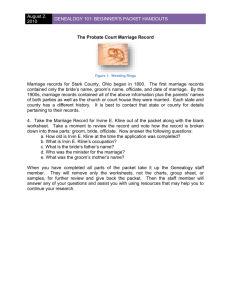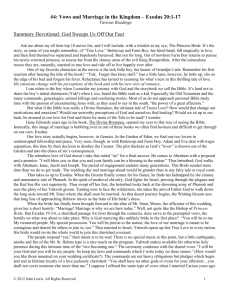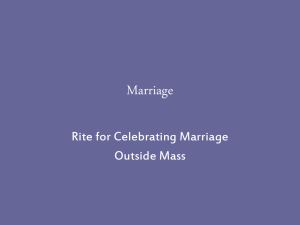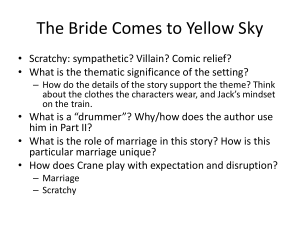Marriage Customs of Korea
advertisement
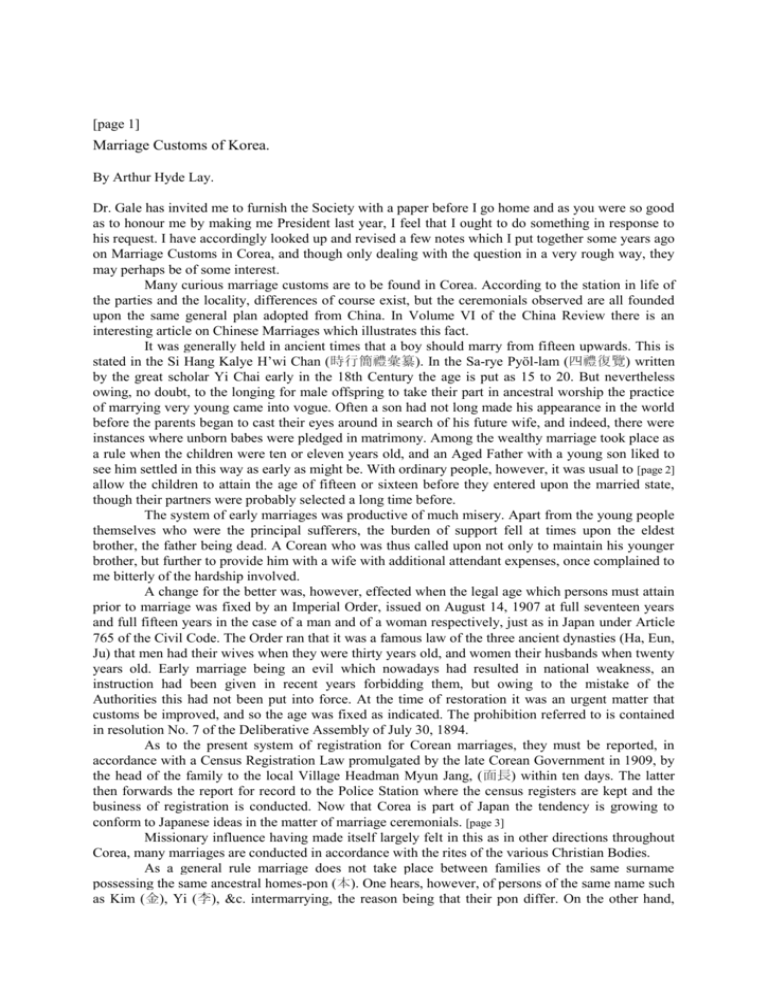
[page 1] Marriage Customs of Korea. By Arthur Hyde Lay. Dr. Gale has invited me to furnish the Society with a paper before I go home and as you were so good as to honour me by making me President last year, I feel that I ought to do something in response to his request. I have accordingly looked up and revised a few notes which I put together some years ago on Marriage Customs in Corea, and though only dealing with the question in a very rough way, they may perhaps be of some interest. Many curious marriage customs are to be found in Corea. According to the station in life of the parties and the locality, differences of course exist, but the ceremonials observed are all founded upon the same general plan adopted from China. In Volume VI of the China Review there is an interesting article on Chinese Marriages which illustrates this fact. It was generally held in ancient times that a boy should marry from fifteen upwards. This is stated in the Si Hang Kalye H’wi Chan (時行簡禮彙纂). In the Sa-rye Pyöl-lam (四禮復覽) written by the great scholar Yi Chai early in the 18th Century the age is put as 15 to 20. But nevertheless owing, no doubt, to the longing for male offspring to take their part in ancestral worship the practice of marrying very young came into vogue. Often a son had not long made his appearance in the world before the parents began to cast their eyes around in search of his future wife, and indeed, there were instances where unborn babes were pledged in matrimony. Among the wealthy marriage took place as a rule when the children were ten or eleven years old, and an Aged Father with a young son liked to see him settled in this way as early as might be. With ordinary people, however, it was usual to [page 2] allow the children to attain the age of fifteen or sixteen before they entered upon the married state, though their partners were probably selected a long time before. The system of early marriages was productive of much misery. Apart from the young people themselves who were the principal sufferers, the burden of support fell at times upon the eldest brother, the father being dead. A Corean who was thus called upon not only to maintain his younger brother, but further to provide him with a wife with additional attendant expenses, once complained to me bitterly of the hardship involved. A change for the better was, however, effected when the legal age which persons must attain prior to marriage was fixed by an Imperial Order, issued on August 14, 1907 at full seventeen years and full fifteen years in the case of a man and of a woman respectively, just as in Japan under Article 765 of the Civil Code. The Order ran that it was a famous law of the three ancient dynasties (Ha, Eun, Ju) that men had their wives when they were thirty years old, and women their husbands when twenty years old. Early marriage being an evil which nowadays had resulted in national weakness, an instruction had been given in recent years forbidding them, but owing to the mistake of the Authorities this had not been put into force. At the time of restoration it was an urgent matter that customs be improved, and so the age was fixed as indicated. The prohibition referred to is contained in resolution No. 7 of the Deliberative Assembly of July 30, 1894. As to the present system of registration for Corean marriages, they must be reported, in accordance with a Census Registration Law promulgated by the late Corean Government in 1909, by the head of the family to the local Village Headman Myun Jang, (面長) within ten days. The latter then forwards the report for record to the Police Station where the census registers are kept and the business of registration is conducted. Now that Corea is part of Japan the tendency is growing to conform to Japanese ideas in the matter of marriage ceremonials. [page 3] Missionary influence having made itself largely felt in this as in other directions throughout Corea, many marriages are conducted in accordance with the rites of the various Christian Bodies. As a general rule marriage does not take place between families of the same surname possessing the same ancestral homes-pon (本). One hears, however, of persons of the same name such as Kim (金), Yi (李), &c. intermarrying, the reason being that their pon differ. On the other hand, there are cases where those of different surnames are not permitted to marry each other, because they are said to trace their origin to a common source. Young people are not consulted as to their inclinations: in fact they have seldom even seen one another before becoming husband and wife. The parents exercise supreme authority in the matter. Hence much affinity or romantic affection cannot be looked for. The writer was, however, once given to understand by a Corean of the Yangban class, that second marriages were as a rule love matches, at least on the man’s side. His opportunity to please himself in selection had come, but as objections were entertained among parents to allowing their girls to become the wives of widowers, the choice often required to be made from a lower stratum of society. Against a widow a much more marked prejudice used to exist with the result that she was made to feel the extreme impropriety of her forsaking the memory of her late husband by being regarded as occupying the position merely of a secondary wife. Prior to the reign of King Sung Jong who ascended the throne in 1469 widows had been allowed to remarry, but His Majesty gave orders that the practice should be discontinued. On July 30, 1894 it was resolved by the Deliberative Assembly that widows might remarry (resolution No. 8). Let us suppose that a youth had reached the age at which his parents considered it advisable that he should be wedded. Having first of all ascertained by private enquiry that a certain maiden was likely to prove suitable as regards appearance and [page 4] the other requirements of eligibility they resorted to the indirect negotiation so favoured in the Far East. That important and useful personage, the gobetween who may be of either sex, CHUNGMAI (中媒), called also MAIPA (媒婆), in the case of a woman, was deputed to undertake the delicate task of broaching the subject to the young lady’s parents. Were it intended to take the proposal into serious consideration, the latter for their part despatched their own delegate to the house of the would-be father-in-law to ascertain the qualifications of the young man. The preliminary investigations having been concluded to mutual satisfaction, formal negotiations were proceeded with at once in a business like manner. For the sake of illustration, we shall describe what is likely to occur. The details which we give are taken from a case we know of which occurred about 5 or 6 years ago, and of course the interval between each stage in the proceedings may vary according to circumstances. Let us say that in the 5th month — at that time the Coreans still adhered to the old Chinese calendar — the work of the intermediary is concluded. On the 13th day of the 6th month the first important step is taken by the parents of the future bridegroom. This consists in sending the SAJU (四柱) — a document wherein are inscribed the four sets of two characters each, specifying the year, month, day and hour of birth of the son — to the Father of the chosen one. Now the Saju represents a marriage note handed over for the purpose of ratifying the agreement. In reply, twelve days later, comes a letter bearing the words Yon-gil (捐吉) on the envelope, which is known as the TAIK IL (擇日) (choosing the day), naming the date of the marriage. Then both families commence earnest preparation for the approaching event. On the last day of the month the fiance makes himself ready for his new honours by going through the ceremony of doing up his hair, KWAL LE (冠禮), the hair being arranged by some one specially selected as being a lucky person. In the days before hair cutting came into fashion, an unmarried youth in Corea was distinguished by [page 5] bare head and hair tied in a plait falling down his back, and to do up the hair and put on a hat, to get married, and to become a man were three things interdependent. With the putting up of the top knot a new name KWAMMYUNG (冠名) is bestowed on the lad. At the same time he puts on the POKGON (幅巾) or silk gauze cap worn by boys at weddings and the CHORIP (草笠) or straw hat, in use by newly wedded youths. Sometimes indeed a man put up his hair without being married but this was done unostentatiously and was considered in the highest degree improper. The prospective bridegroom having thus observed all the formalities necessary to entering upon man’s estate, the marriage deed or contract is drawn up by his father for presentation to the other contracting party. The document approximately runs thus:“With double reverences I, So and So, descendant of such an One, present my respectful wishes on this……day of the year…… for Your Honour’s manifold happiness, and hereby humbly agree, with your gracious favour and permission to your daughter’s becoming the wife of my son……who is of age and a bachelor. It is the custom of our ancestors and wedding presents are bestowed. With respectful wishes I offer this document and beg that you will note its contents.” On the envelope is inscribed the name of the Father of the bride elect. This instrument together with the Saju (四柱) and the Taik-il (擇日) constituted the record of the marriage; for in Corea there was formerly no system of public registration of weddings, a fact which in my early days in Corea a Corean official of a reforming turn of mind stigmatized to me as regrettable, expressing the hope that, in view of the grave inconvenience entailed, some proper method of recording such events might before long be introduced. The available documents therefore were doubly precious and as such carefully preserved. It was commonly said that they should be kept till the daughter had brought forth at least one son, though the [page 6] advent of three sons was said to be necessary before they could be disregarded, the idea being that male children consolidated the position of the wife by arousing the regard of the husband on the one hand and on the other by anchoring the woman to the spot where her sons lived. Before such an auspicious event the man might desire to dismiss her arbitrarily or she might be inclined to run away through lack of any retaining influence. Should, however, the wife leave of her own accord or be sent away for any reason, the contract was given back. As to the gifts to which reference is made, they are called NAPCHAI (納釆) or NAPPEI (納幣), presents of silk. Custom regulates their quantity and quality in accordance with position. In the instance we are considering they consist of two pieces of Chinese silk, one of a blue colour wrapped up in red paper, the other red and folded in blue paper and two skeins of silk thread, one blue, the other red, to correspond with the stuff. A girl who marries a bachelor wears the red garment outside and the blue underneath, but where her consort is a widower the order of the garments is reversed. Along with the marriage deed enveloped in a cloth, these offerings are placed within a black lacquer box enclosed in two coverings of red cloth. In some cases, however, two boxes are used to contain the gifts, one black, the other red. Thus the parcel is conveyed to its destined recipients during the evening of the 12th day of the 7th month, the eve of the wedding day which has itself been selected as propitious by the aid of an expert in the art of choosing lucky days. In the country the gifts are usually sent on the wedding day, not the previous evening. In order to conform to precedent the ceremonial of presentation calls for the services of a box carrier for whom the orthodox dress is a red overcoat with hat of the same colour and black shoes. In some parts of the interior the coat is blueblack with hat to match. He is accompanied by four lantern-carriers in black coats, and six or seven torch-bearers. The procession is met by torchmen from the other house and escorted to its goal where the casket is deposited upon a table placed in readiness. [page 7] Thither as early next morning at 7.30 the bridegroom elect sets out to take part in the appointed ceremony. In full court cap, dress and shoes he is seated upon a white horse, gorgeously caparisoned — we are citing as an example the case of a bachelor, for though he has the alternative of making the journey in a chair carried by four men, a widower should never go on horse back. In front, walk two servants carrying paper umbrellas, and the rider is attended by a groom in black coat and hat. The train is further composed of one of his relatives acting as bestman on a steed of some description, it matters not what, two pairs of lantern carriers — the rich sometimes have ten pairs or so — a goose carrier clad in red, the same individual who has already taken the presents, bearing the live bird, the emblem of conjugal fidelity, wrapped in a red cloth — or a wooden figure in the form of a goose may be employed — six female servants clothed in upper garments of green and lower garments of blue and a YUMO (乳母) or nurse in a two-man chair. It must here be mentioned that most of the costumes and other things required in connection with a marriage are only borrowed for the occasion. In Seoul and other large cities there are establishments which make it their exclusive business to keep such articles for hire. In some country places the outfit is village property and as such is at the disposal of the residents free of charge. Neighbouring villagers wishing to share its use are compelled to pay. One of the bride’s male relations, say some ten years older than the bridegroom, welcomes him coming thus with proper pomp and circumstance. The latter bows once in silence and the other merely bends his body slightly in return. Bows are exchanged when the relative positions of the two men are approximately equal. Arrived at the house the party enters the courtyard which is shaded from the sun’s rays. Care must be taken by the future husband and those with him on first admittance to avoid violating the Chu-dang (周堂) or prohibition against being found by evil spirits in such part of the premises as they may happen to be frequenting. Similarly with the wife [page 8] when she makes her debut in her new home. Inside the fence or wall a small table is prepared for the reception of the goose. The bridegroom then goes through the prescribed ceremony. The bird is handed to him by its bearer, and having assumed a position at a convenient distance, he holds it in his arms, takes three steps forward and deposits it upon the table, then stepping backward in like manner, with the assistance of the man in charge of the goose, performs two obeisances in its direction in token of his desire that the faithfulness of which it is the embodiment may rest upon his union. The next scene takes place within the house. The bridal table, TOK-JA-SANG (독자상), before which the pair plight their troth, has been spread with specially prepared meats consisting of a male chicken, cooked, with a red date in its mouth and a dish of red dates before it, a female chicken, cooked, having in its mouth a white chestnut with the skin peeled off, and in front of it a dish of raw chestnuts, and also a plate of moon-shaped cakes, twenty-one in number. At two corners of the table are wooden candlesticks with lighted candles of wax and at the other corners are TONGJA (童子) or wooden images representing children. Behind the table is a high screen to conceal the bride till she comes forth to commence her acquaintance with a strange person of the opposite sex. The man having taken up his station, she appears in bridal array, wearing a wedding cap, CHYOKDORI (族頭里) and clad in a WON-SAM (圓衫), a kind of cloak which is also used as a shroud at her burial, having a dragon headed hair pin in her hair, and she stands at the other side of the table. Then they pay their respects to each other in the customary fashion. The woman first of all performs four obeisances, assisted therein by a maid servant at each side. Having already made two reverences before the goose, the man, also helped in the performance, contents himself with bowing twice. A widower marrying for the third time is only supposed to make three obeisances in all, and for the fourth time only two. The lady wears a long garment to conceal her feet as a mark of honour to the bridegroom, who in courtesy has long sleeves covering the hands. [page 9] Her eyes are understood to be fastened up, but this custom, like many others, is often more honoured in the breach than in the observance, and she may simply keep her eyes shut. It is contrary to etiquette for her to utter a word on her wedding day. The bowing finished, the ceremony of drinking wine, three cups of which are presented to each, remains to be performed. Here again, however, the wine is not of necessity actually consumed. The cups are exchanged through female servants, waiting one on each side of the table, and instructed by some of the bride’s relatives. Those passing from the bride to her husband make their way along the right side of the table, those from him to her along the left side. The reason given is because in Corea the left side is honored by men and the right by women. Sometimes the husband drinks a little of the wine but the wife abstains, though all the same each must touch the cup with the lips. After this is over, the newly married couple may sit down together for the first time. The whole function described having lasted for about an hour, the bridegroom is conducted into a specially prepared room where he is regaled with a feast along with the best man, who retires immediately the repast is concluded, and the servants are likewise entertained in the proper place. At noon comes the “going away,” the wife departing behind her lord and master, like a dutiful Oriental spouse, carried by eight bearers in a chair the roof of which is decorated with tiger skins. She is followed by two umbrella-carriers and four lantern-bearers in the black coats, called HEUK-EUI (黑衣), used by chair men and official servants, twelve maids with garments, green above and blue below (in olden times the lower garments were red, and even now small girls have them of red), the YUMO (乳母) or nurse, in a two-man chair, and a room attendant PANG-JIK-I (房直) following. The Jinrikisha is often employed as a modern innovation in the procession. Returned home the bridegroom does reverence to his parents. Presents of money are bestowed upon all the attendants. At one o’clock in the afternoon, so that no time may be lost, the union is, as it were, consecrated through a visit paid by [page 10] the pair to the temple containing the ancestral tablets of the bridegrooms’s house, where are spread offerings of wine, fruit and dried fish. Each of them reverently inclines the head two times. When the family does not possess any such tablets, the same rites are gone through in the house before screens on which are pasted papers, CHI- BANG (紙榜), inscribed with the titles and degree of relationship of the four preceding deceased ancestors, both male and female. Now the bride is in a position to make the acquaintance of her father and mother-in-law, though some authorities hold that the introduction should take place prior to the visit to the temple. On this occasion she presents to the former a dish of dates, and to the latter a cooked pheasant, and to both three cups of wine, making an obeisance in each case. The other members of the family to which she has been admitted are next made known to her. Immediately afterwards the time comes to do especial honour to the bride and she goes through a ceremony which is called KWAL LE (冠禮), as in the case of the man. Her hair already dressed for the wedding is undone and then braided into two coils and fastened in a knob by her mother-in-law. She is adorned with an artificial head dress, a dragon-headed gilt hair-pin, a wedding cap, and also receives seven upper garments of Chinese silk, a red Chinese silk under garment, as well as jewellery, hair pins, finger rings and clothing of various kinds. Thus fitted out, she is entertained at a banquet. Later in the afternoon the couple return to the house of the bride, where they spend three nights. The morning following the wedding the son-in-law is introduced to his relatives by marriage and his parents-in-law make him a present of a suit of clothes, a hat with horse hair head-band and shoes. On the third day is the final home coming when all the bride’s belongings are carried with her to the new home where the parents are awaiting the obeisances usual at this time. Three days afterwards the husband is once more taken to his wife’s old domicile, either on a horse or in a chair, supplied by her people. This is known as the second going, CHAI-HANG (再行). [page 11] In out of the way places, this may be done in the wedding month, or postponed till the third month. In the same month the wife is sent on a similar visit, provided with presents of wine, cake and vermicelli. Should some obstacle come in the way and prevent her from going, custom demands that the visit be postponed till the third month of wedded life. In the country where the two homes are separated by long distances, she returns to see her parents in the year of her marriage, but should she be unable to do so, the visit must on the same principle be postponed till the next year but one after the event. What we have described is a full ceremonial such as is observed among the better classes, but variations and abridgments occur to suit individual pockets and positions. For example, amongst the lowest classes the marriage is sometimes celebrated at the house of the bridegroom. Let us glance, by way of illustration, at a Corean wedding in humble life which was contracted within the last six years in Seoul. The whole ceremony lasted about two hours. Close on eleven o’clock in the morning the guests began to assemble at the bridegroom’s house and soon afterwards the happy man himself appeared on the scene mounted on a led pony, white in colour, with high saddle, decorated as to its mane with coins and ribbons and between the ears, with red pompoms. Two men walked in front, one carrying a large oil paper umbrella, the other the goose, while two attendants, also with similar umbrellas, followed in the rear. By and by a messenger came hastening to say that the bride was near at hand, and she arrived in a closely covered Corean chair, smartly curtained and hung with tiger skins. Behind attendants bore her paraphernalia. By her chair walked two women who upon reaching the house lifted her out and almost carried her into the small room. After making her obeisances she was supported till she reached her allotted place on the wooden floor. Her eyes were firmly sealed, her face thickly coated with white flour, her eyebrows fashioned into a narrow line to make them conspicuous, the hair over her forehead brought into the straight conventional shape by the pulling [page 12] out of superfluous hairs, the cheeks and lips painted red. Brightly coloured silk formed her dress. After the wedding the female guests crowded round and submitted her to a minute inspection and the poor girl had to remain thus till sunset motionless. In this case the bride was sixteen, her husband about twenty and to follow their fortunes a little further, they now live with his mother of whom he is the eldest son, the daughter-in-law taking the chief part in the care of seven young brothers and sisters-in-law, leaving the older dame free to attend to a small shop. One heard with no little surprise that they were subsequently reported to be a happy family. Altogether the position occupied by a married woman is nominally a low one, as can be gathered from the terms by which she is referred to. She has no name of her own, but is known by the name and title of her husband with the word “house” placed after then, as Mr. So and So’s house. It is unusual for persons other than relatives to make enquiries regarding a man’s womenfolk, but when his wife is alluded to by him he speaks of her as “that person,” as Ko Siki, which is an word without meaning, or he uses some other disparaging expression. Marriages in the old way, it can readily be imagined, are a cause of much useless expense which bears heavily upon the poor who can not really meet the outlay and have to borrow money to keep up the appearances supposed to be called for on such occasions. Thus matrimony is begun in debt from which it is not easy to secure freedom in after life. It may be worth while noticing what the Coreans themselves have to say about their national observances on the occation of a marriage, and therefore from the columns of the “Cheguk Shinmun” (帝國新聞), a Corean newspaper formerly published in Seoul, I took in 1906 the following particulars of customs observed in various parts of the country. In Kyöng Geui (京畿), Ch’ung Ch’öng (忠淸), Kang Wŭn (江原) and Kyöng Sang (慶尙) Provinces marriage customs are practically identical, differing only in details, but in the North [page 13] and West and everywhere by the seashore they are of a special character. In the two first-named divisions of the country the initial step is taken by the parents of the bride in passe who transmit a CHU DAN (柱單), or letter asking for the SAJU (四柱) to the house where the young man lives. Formal consent to the marriage is regarded as having been obtained when the latter document is forthcoming in response, and the rupture of an engagement is a grave matter involving the return of the SAJU (四柱). When all the arrangements for the union are completed and the day fixed is about to arrive, a marriage note HON SO CHI (婚書紙), with a trifling gift of two undergarments, is sent to the bride’s house in a lacquered box. On the auspicious occasion a goose is presented and the wedding table, HON PAI SANG (婚配床), is placed between the bride and bridegroom and the ceremony takes place, consisting in the exchange of obeisances, four rendered by the woman and two by the man in return. In the northern and western districts negotiations are originated by the despatch of a middlewoman, MAIPA (媒婆), to the girl’s house. Should her parents be agreeable, they await the receipt of a formal application before granting their sanction. When the wedding day comes, a contract note may or may not be given, but there is no bestowal of garments or box, nor are there any bowings. In these places a goose is employed at the ceremony only by persons of rank and wealth who do not exceed two or three in a district. In ordinary cases the bridegroom, wearing a student’s overcoat, DO-PO (道袍), or occasionally official clothes, KWAN-BOK (官服), proceeds on horse back to the house of the bride where he is received in a room made ready, and regaled with special food placed upon a large table called the KUN-SANG (큰상). At this moment DAN-CHA (單子), notes written in common language and couched in a jocular and personal strain, asking for food, are brought to him from the scholars of the neighbourhood. On these he inscribes short sentences in reply but if his ignorance be so great that he requires to enlist the services of his best [page 14] man, HU-PAI (後陪), for the purpose, he is made a laughing stock of. At sunset the bridegroom is introduced into the bridal chamber. After three days the CHOK-CHANG-PUB (足掌法) or practice of beating the soles of the feet, is observed so severely that the bridegroom is pained almost beyond endurance. At Wi-ju (義州) when the KUMSANG (큰상) is placed before the bridegroom, young scholars subject him to much teasing and buy the table from him. In the provinces of Kyöng Geui (京畿) and Ch’ung Ch’ong (忠淸) it is customary among gentle-folk to make the family of the bride, if they have any means at all, responsible for almost the entire providing, while the bridegroom’s people are content with supplying two undergarments of female attire. The former must furnish two pairs of blankets and even the common utensils, combcases and brass dinner vessels for the young couple, and also the bridegroom’s clothes ― indeed so far does their duty in these matters extend that they must keep the bridegroom in raiment for years afterwards. Not unnaturally under the circumstances many daughters are said to be the ruin of a house. In parts of the Pyung-An (平安) and Whang-Hai (黃海) Provinces there are in force ceremonial regulations which apply to high and low, rich and poor, alike. It is laid down that when the subject of marriage is broached, the market value of the girl shall be referred to as if the transaction concerned the buying and selling of cattle. She is worth at least two or three hundred Yang (兩) and sometimes more than a thousand, and the contract money is paid over before the marriage is fixed. Of late the sum demanded is reported to have varied according to her age, each year of which, from the time she is first marriageable till she reaches what is considered to be the prime of her maidenhood, advances her price by one hundred Yang (兩). Therefore supposing that she would fetch eight hundred Yang (兩) at eight, at ten she is worth a thousand. Scarcely is there a woman in these parts who is not a wife before she is fifteen. In the majority of cases she is married at seven or eight because of the preponderance of poor people. Notwithstanding [page 15] that her parents thus make a profit by her, they prepare no clothes for the bridegroom. The practice of selling daughters is observed even by the rich, but there are some such who do not dispose of them in this way, though they do not exceed ten in a district. Social position is at a discount, and all that people care for is to get a good offer for the hand of their daughter. Even a servant if he have the sum needful can easily procure a wife, while a gentleman’s son in poverty is at his wits’ end. Here the love of money would therefore appear to be the root of all matrimony. Those who have many daughters are counted among the wealthy in contradistinction to their fellow-country men in Kyöng Geui (京畿) and the southern regions. In recent years many inhabitants of the North-west having emigrated to the provinces of Ham Kyeng (咸鏡) and Kang Wŭn (江原), the custom of receiving money for the bride has been carried with them. In spite of their monetary value, daughters are cared for very badly and when they go away as married women they are treated worse than servants and have to take their food outside. If they are unfortunate in their parents-in-law, they lead lives of misery, eating the burned remains of the rice and doing all kinds of farming work, except ploughing, in addition to sewing, weaving and cooking. In the course of time their lot is ameliorated by the transfer of the larger share of the burden to the shoulders of their own daughters-in-law. The most miserable women in the world may accordingly be said to be those of the Western part of Corea. Amongst the lowest class in Seoul there is a custom of sending to the bride some days before the wedding pieces of silk and cotton, green stuff for the cloak, money, hair-pins, finger-rings, &c., as PONGCHI (봉치), in a lacquer box, but if the offering be a meagre description, it is sometimes slightingly rejected.
